Hi all
Thought I would do a write up on the fitment of a top of the range LPG Prins Vapour Sequential Injection (VSI) kit to the LS430 here in the UK.
I used to work for an installer so I have used his premises and equipment for this, it’s so much easier when all the necessary tools are to hand.
I didn’t take as many pictures as I intended due to time pressure but the following will give an idea of whats involved.
This is what we started with.... looks nice and smooth....
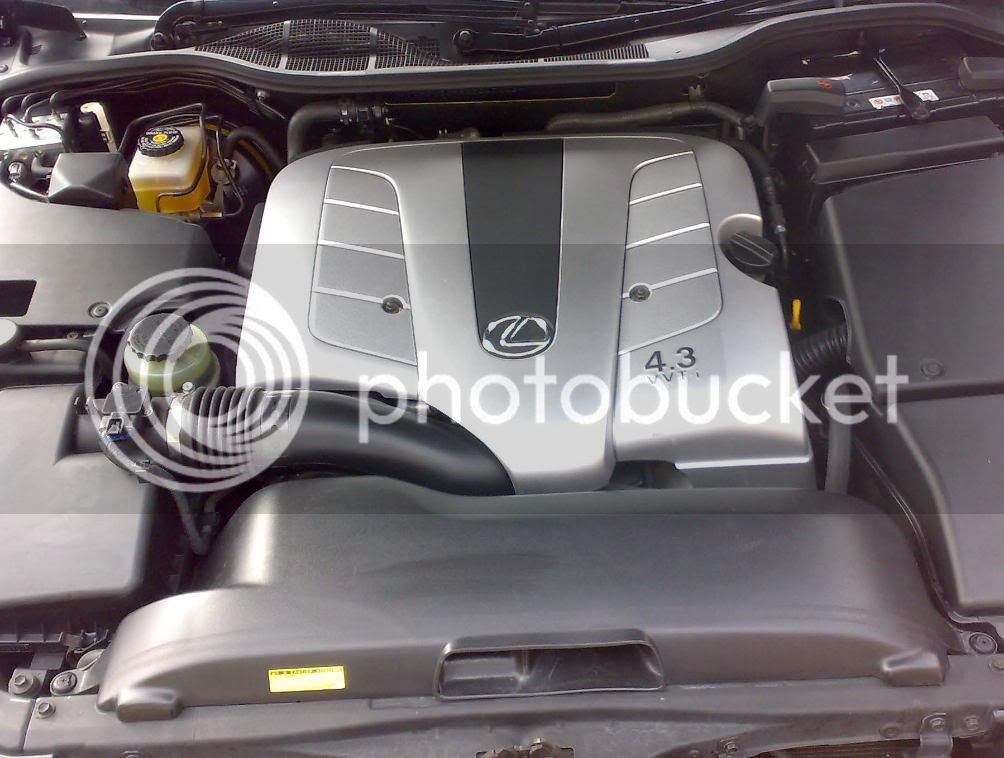
After removing the cover we are left with this
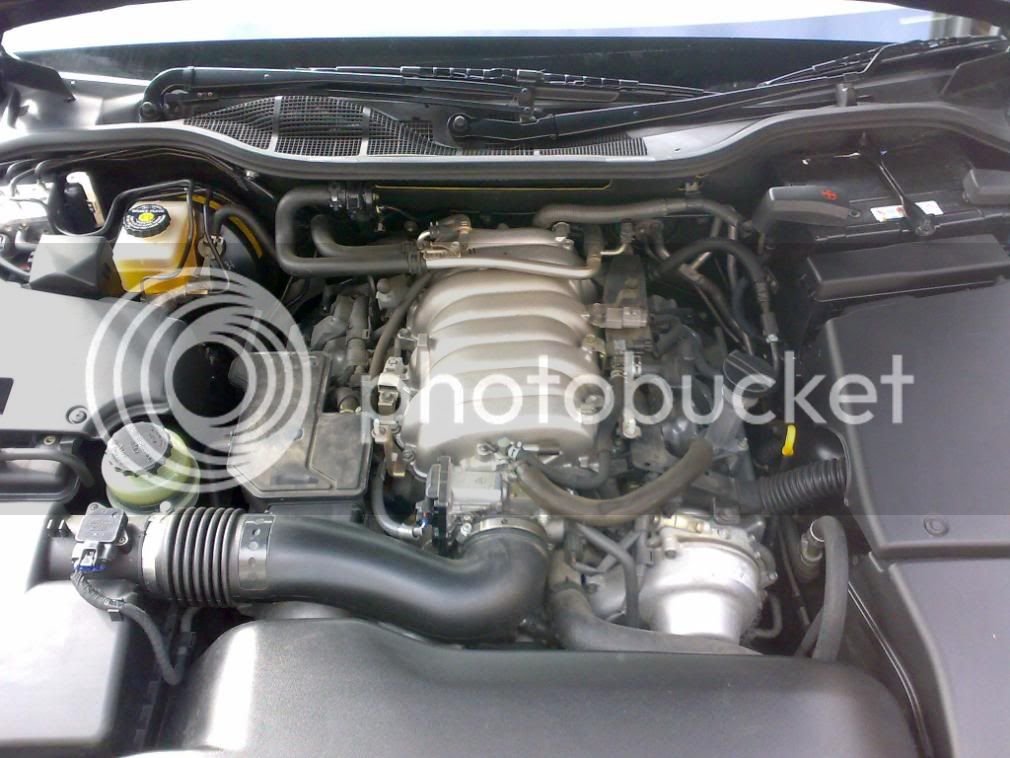
The next job is to find a place under the bonnet for the hardware
A vaporiser (turns the liquid gas into vapour) A bracket was made to fit this to the top left of the engine bay, the bracket fixes to one of the servo mounting bolts and to the bracket for the power steering reservoir. All brackets are custom made from 3mm steel plate, they are painted with acid etch zinc primer then satin black, this usually outlasts most standard paint under the bonnet!!
The Prins ECU (computer brain) was fixed directly to the side of the original ECU housing with a bracket. The fixings were sealed to ensure water tightness of the housing. This picture is before fitting.
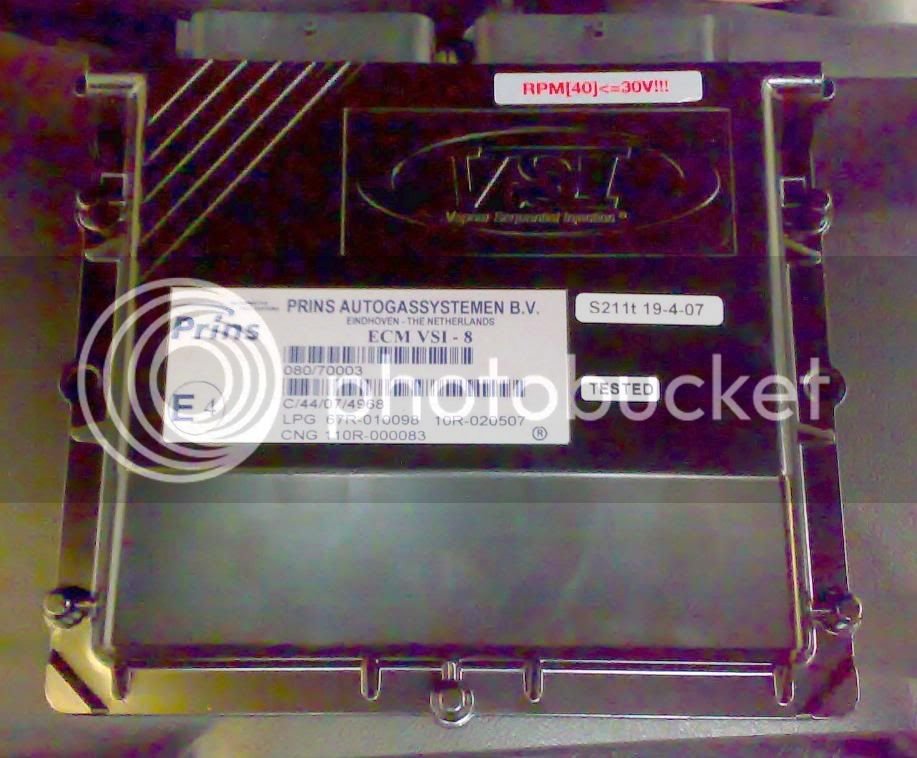
Two sets of injectors (control the input of vapour) Mounted by custom made brackets to the inlet manifold
LPG filter. This is very light in weight so is fixed via its short length of LPG hose to the vaporiser.
Emulators (help the original ECU to think the petrol injectors are working when they are not!!) These were fitted below the right middle plastic shield, they fitted very tightly and only needed a cable tie to prevent movement. You have to be careful of the ignition amplified that is under here as it gets very hot in use, it’s easy to see as it has alloy cooling fins.
Then the connections to the vehicle.
The heater hot water circuit (to warm the vaporiser) was made in two places for flow and return from the heater pipes that connect the engine to the heater within the car. Purpose made “T” pieces are used of the correct size and proper Jubilee clips used not the cheap pattern ones.
The nozzles into the inlet manifold (to supply the gas to the engine) are drilled and tapped into the inlet ports at the same distance from the valves on each cylinder.
Connections to the original ECU. All electrical connection are soldered and covered with shrink wrap to ensure perfect joints. Reference is made to the original wiring diagram and connections made. All eight cylinder injector wires are cut and connected to the emulator wiring (any fault in the LPG kit and the default setting is straight through to petrol so you cannot be left with no fuel if the LPG system fails) Additional connections are made for a RPM signal (usually camshaft sensor) Two Lambdas (the ones before the cats) Ignition switched live, permanent live, Ground. This is a picture of the cars ECU before connection.
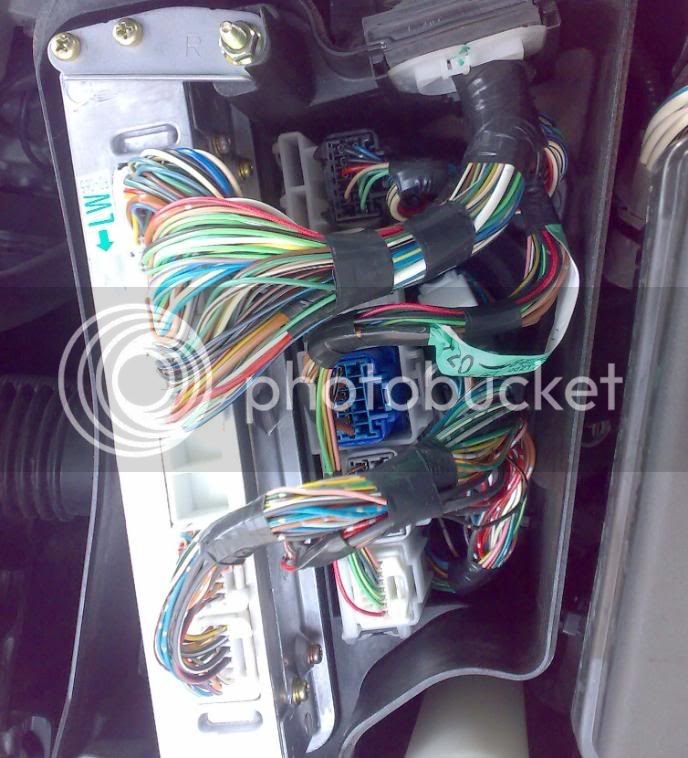
This is the wiring loom of the LPG kit... it looks worse than it is..
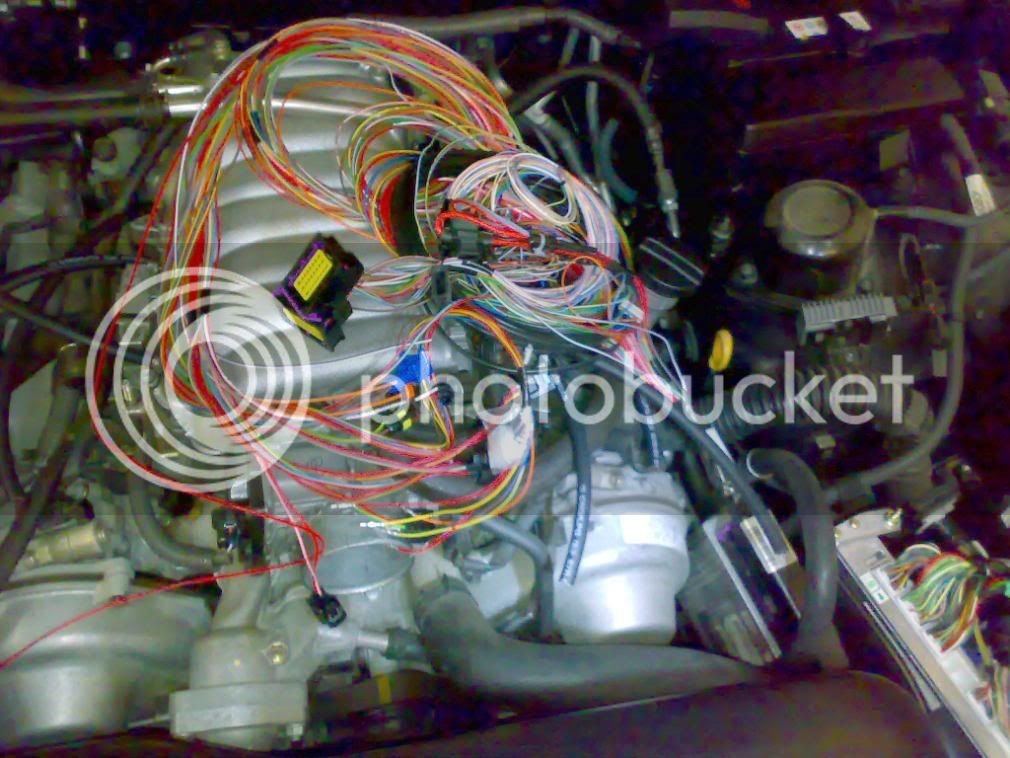
This is the ECU after connections
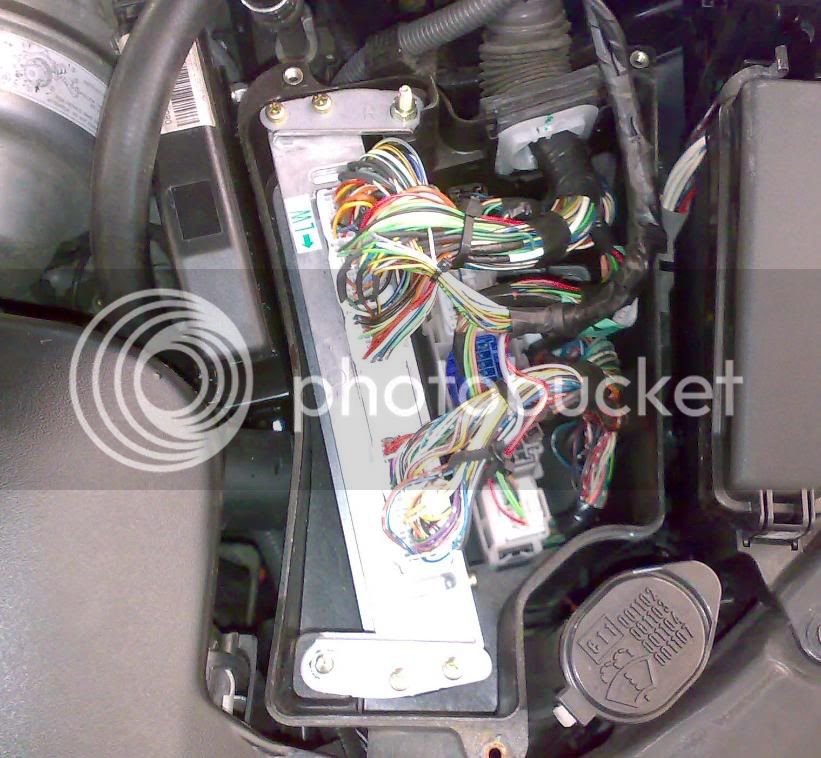
So after all that you end up with an engine bay that looks something like this.....
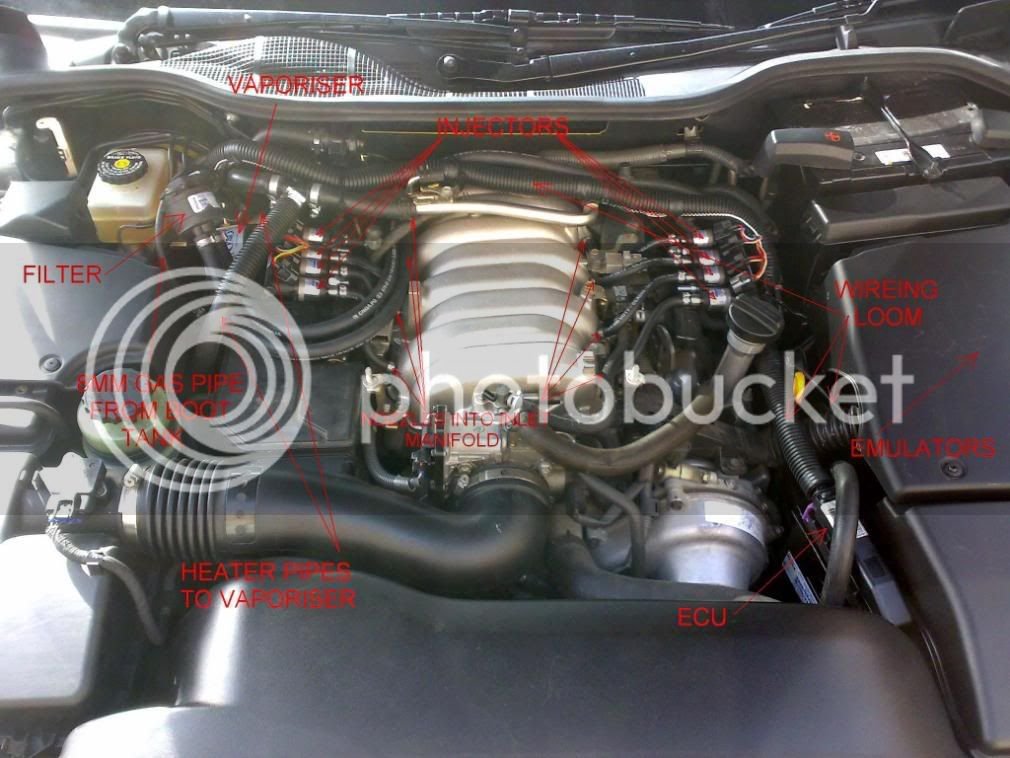
You then have to wire in the dash switch, getting the wiring into the car from the engine bay is sometimes very difficult but Lexus are kind and there is a large rubber grommet next to the battery that comes out behind the glove box. You can have the switch virtually anywhere, I chose to keep the centre console looking original and fitted it next to the cabin air temperature sensor, if needed it can be removed and the damage left behind fixed cheaply by just replacing the small plastic trim piece. This picture shows the switch with a full tank of LPG, all four Led’s are lit, there is a built in sensor to dim these at night should they be in vision.
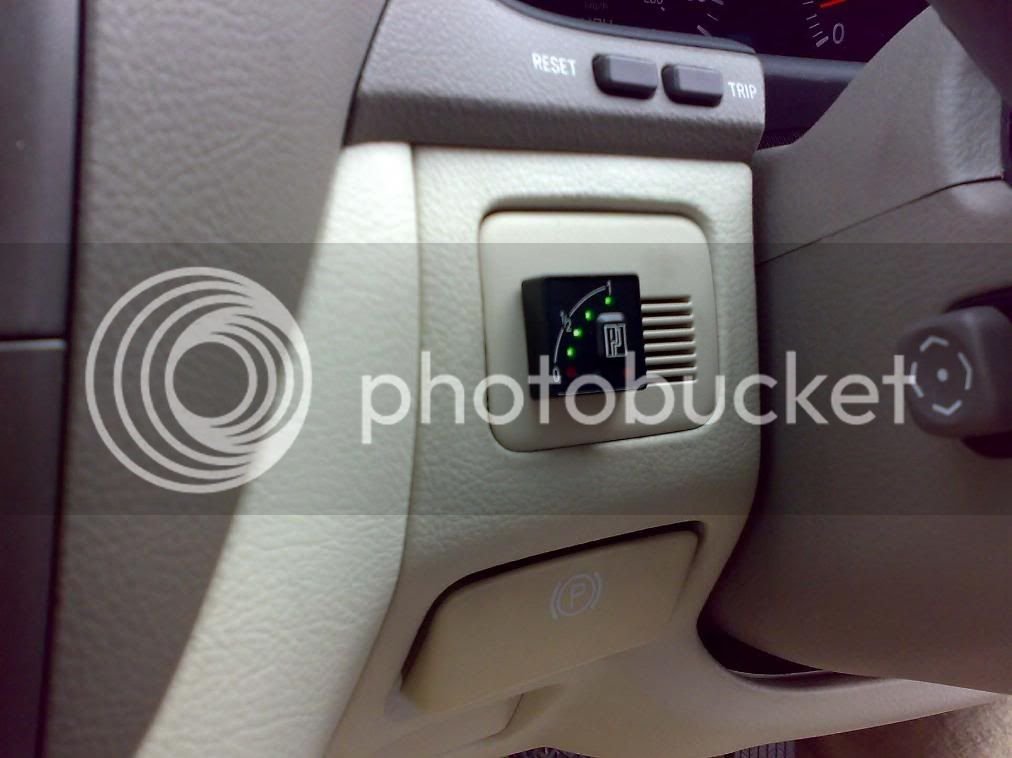
Next we move to the boot....
Originally I was going to use a 67 litre 4 hole tank as this fits without modification but unfortunately the one ordered for me had been used on another job as I was two weeks late in getting it converted due to being rear ended by a Discovery , so instead of waiting for another I found an 82ltr tank that was the correct depth to allow a flat boot floor but was a bit too big, so I had to do a bit of panel beating to get the tank box to fit, the tank fitted the wheel well exactly but the box hit the side of the boot, this was dressed back about an inch after checking underneath for clearance, anyway it didn’t take much but it did crack the paint so it was sanded and repainted both inside and underneath.
The tank is held in place with four brackets that bolt through the boot floor, these are made for each application to ensure the best fit.
An 8mm plastic coated copper gas pipe is connected to the tank and fed out the boot floor underneath the car and up into the engine bay, there are so many rules and regs on its path and its safety and security that they fill a book but it’s just a case of common sense, keep away from exhaust pipes, moving suspension etc, make sure it can’t get trapped or squashed if the car bottoms out.... The pipe is fixed securely with “P” clips. A multicore wire also runs from front to back to control the solenoid on the tank, and wire in the tank level gauge.
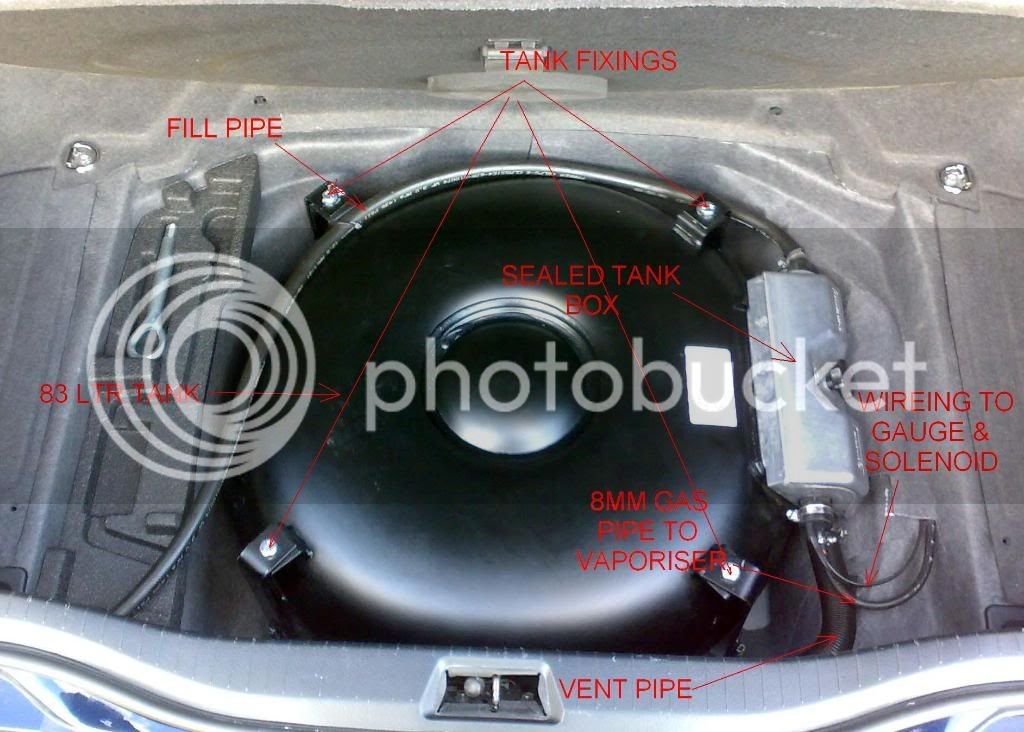
The next part is good fun or horrendously bad depending on your point of view, take one 70mm hole cutter and attack the rear wing of your pride and joy...... When you have a nice disc removed, you tidy up the burr then file two slots top and bottom to stop the filler from moving, paint the raw metal edge, spray liberally with rust preventer and fit the filler. I had mine colour matched to the car, they come in standard Black. A high pressure large bore fill hose connects the filler to the tank and you are nearly there. The advantage of a 4 hole tank over a single hole tank is that they fill much quicker as it uses one hole for filling, one for a pressure relief valve, one for the gauge and the last for the supply, The single hole tank uses one hole for all four things, they are a bit cheaper but take ages to fill up, a four hole fills about as quick as a petrol pump dispenses.
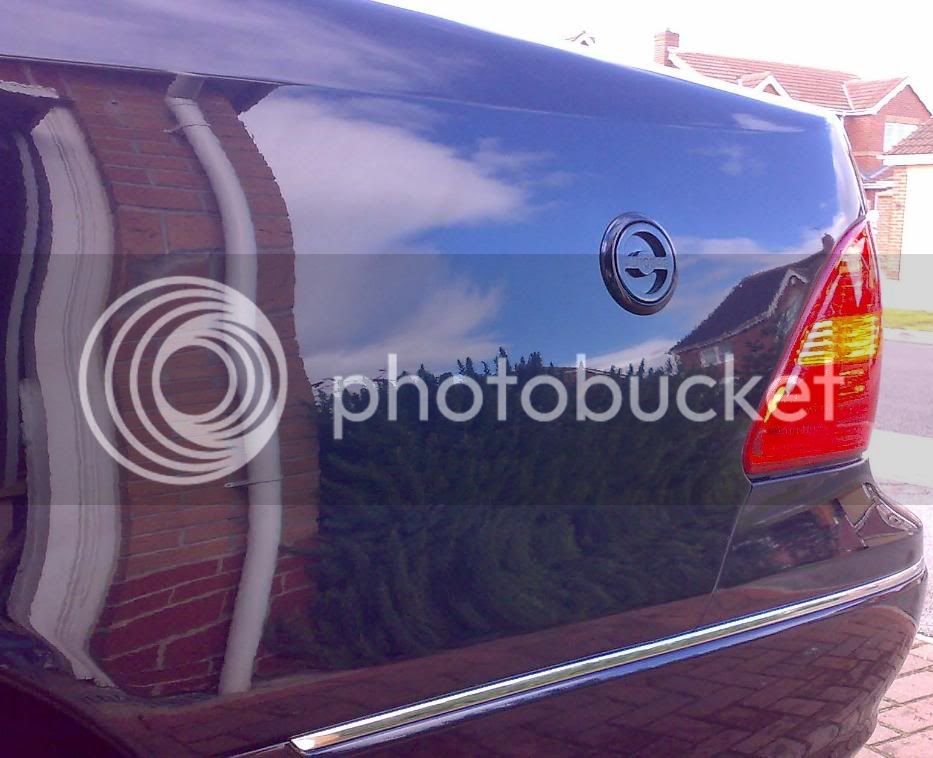
The filler and the tank box have to be sealed from the inside of the car and vented. The filler is vented from the fill up side. The tank box is vented through the boot floor. This photo shows the inside of the rear wing where the filler is.

This is the only intrusion into the boot the boot floor fits flush as before.
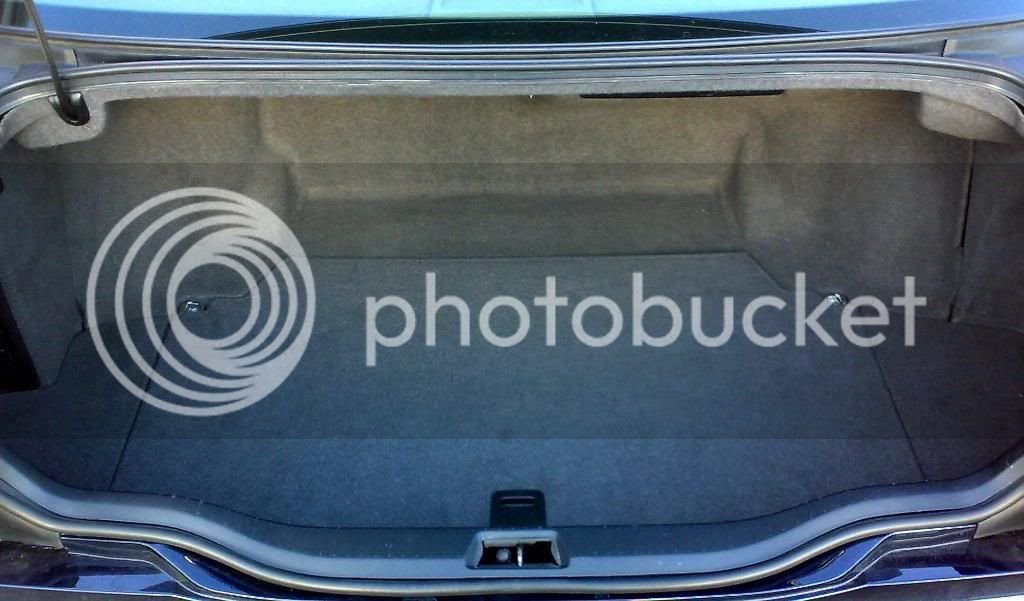
Next job is to fill the tank with gas, checking for leaks from the fill hose. Then connect a laptop to the Prins system and check all parameters are correct and to initialise the system, it is set to start on petrol and then switch to gas at 35 deg C, when hot it starts on petrol and changes after 0.5 sec. You do not have to rev it like the old systems.
The entire system is then checked for leaks and security.
An OBD11 reader is plugged into the car and it is taken for a test drive, I won’t go into all that’s checked but it usually works OK first time if setup correctly, you usually just check lambda readings and fuel trims.
When all is well and working as should be then it is time to tidy up the install, I cut the boot carpet to fit back around the tank and trimmed the tool holder, omitting the jack and handle as I haven’t a spare now anyway (apparently according to the AA the average motorist has a flat tyre every 97,000 miles, so I should be OK for a while)
Then tidy up the engine bay, wrapping the wiring in convoluted tubing etc. I had to trim the side of the engine cover to make it fit nicely, but I had checked it at various stages to ensure it would fit back easily.
So here is the finished engine bay
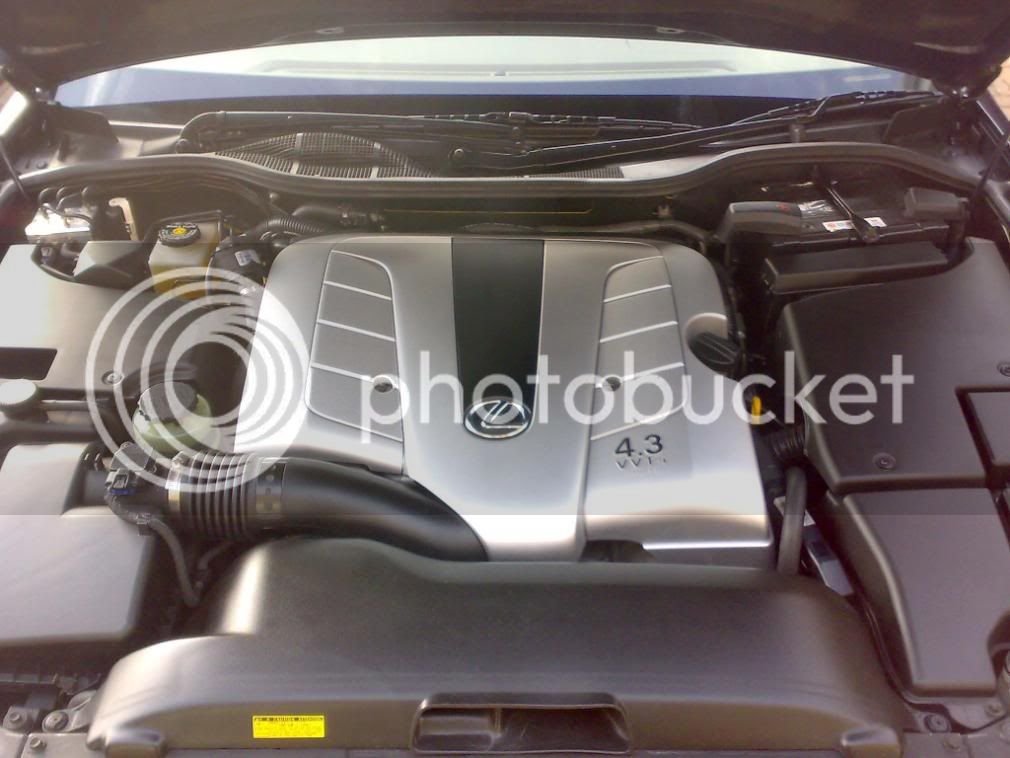
You can just see the filter at top left and the ECU at bottom right.
I have done about 2000miles since I finished it and it has run perfectly, there is no loss of power, in fact it feels like it has more power, it is smooth and clean all the way through the rev range, the only way to tell it is on gas is to look at the switch.
One interesting thing is the petrol gauge, it still goes down and the distance to empty still falls, it’s between ¼ and ½ full and it drops until its nearly empty then jumps back up to the correct reading then starts again. This is because the gauge will only take sporadic readings from the tank (unless the level rises i.e. filling up) it then drops because the ECU knows how much petrol is being used by measuring the injector opening times and working out how much you are using, it also gets the MPG etc from the calculation, anyway because it still “thinks” it is on petrol the gauge drops.... a small price to pay for half price fuel....
If anyone has any questions then please ask.
Thanks and I’m sorry if I’ve bored you
Pete
Thought I would do a write up on the fitment of a top of the range LPG Prins Vapour Sequential Injection (VSI) kit to the LS430 here in the UK.
I used to work for an installer so I have used his premises and equipment for this, it’s so much easier when all the necessary tools are to hand.
I didn’t take as many pictures as I intended due to time pressure but the following will give an idea of whats involved.
This is what we started with.... looks nice and smooth....

After removing the cover we are left with this

The next job is to find a place under the bonnet for the hardware
A vaporiser (turns the liquid gas into vapour) A bracket was made to fit this to the top left of the engine bay, the bracket fixes to one of the servo mounting bolts and to the bracket for the power steering reservoir. All brackets are custom made from 3mm steel plate, they are painted with acid etch zinc primer then satin black, this usually outlasts most standard paint under the bonnet!!
The Prins ECU (computer brain) was fixed directly to the side of the original ECU housing with a bracket. The fixings were sealed to ensure water tightness of the housing. This picture is before fitting.

Two sets of injectors (control the input of vapour) Mounted by custom made brackets to the inlet manifold
LPG filter. This is very light in weight so is fixed via its short length of LPG hose to the vaporiser.
Emulators (help the original ECU to think the petrol injectors are working when they are not!!) These were fitted below the right middle plastic shield, they fitted very tightly and only needed a cable tie to prevent movement. You have to be careful of the ignition amplified that is under here as it gets very hot in use, it’s easy to see as it has alloy cooling fins.
Then the connections to the vehicle.
The heater hot water circuit (to warm the vaporiser) was made in two places for flow and return from the heater pipes that connect the engine to the heater within the car. Purpose made “T” pieces are used of the correct size and proper Jubilee clips used not the cheap pattern ones.
The nozzles into the inlet manifold (to supply the gas to the engine) are drilled and tapped into the inlet ports at the same distance from the valves on each cylinder.
Connections to the original ECU. All electrical connection are soldered and covered with shrink wrap to ensure perfect joints. Reference is made to the original wiring diagram and connections made. All eight cylinder injector wires are cut and connected to the emulator wiring (any fault in the LPG kit and the default setting is straight through to petrol so you cannot be left with no fuel if the LPG system fails) Additional connections are made for a RPM signal (usually camshaft sensor) Two Lambdas (the ones before the cats) Ignition switched live, permanent live, Ground. This is a picture of the cars ECU before connection.

This is the wiring loom of the LPG kit... it looks worse than it is..

This is the ECU after connections

So after all that you end up with an engine bay that looks something like this.....

You then have to wire in the dash switch, getting the wiring into the car from the engine bay is sometimes very difficult but Lexus are kind and there is a large rubber grommet next to the battery that comes out behind the glove box. You can have the switch virtually anywhere, I chose to keep the centre console looking original and fitted it next to the cabin air temperature sensor, if needed it can be removed and the damage left behind fixed cheaply by just replacing the small plastic trim piece. This picture shows the switch with a full tank of LPG, all four Led’s are lit, there is a built in sensor to dim these at night should they be in vision.

Next we move to the boot....
Originally I was going to use a 67 litre 4 hole tank as this fits without modification but unfortunately the one ordered for me had been used on another job as I was two weeks late in getting it converted due to being rear ended by a Discovery , so instead of waiting for another I found an 82ltr tank that was the correct depth to allow a flat boot floor but was a bit too big, so I had to do a bit of panel beating to get the tank box to fit, the tank fitted the wheel well exactly but the box hit the side of the boot, this was dressed back about an inch after checking underneath for clearance, anyway it didn’t take much but it did crack the paint so it was sanded and repainted both inside and underneath.
The tank is held in place with four brackets that bolt through the boot floor, these are made for each application to ensure the best fit.
An 8mm plastic coated copper gas pipe is connected to the tank and fed out the boot floor underneath the car and up into the engine bay, there are so many rules and regs on its path and its safety and security that they fill a book but it’s just a case of common sense, keep away from exhaust pipes, moving suspension etc, make sure it can’t get trapped or squashed if the car bottoms out.... The pipe is fixed securely with “P” clips. A multicore wire also runs from front to back to control the solenoid on the tank, and wire in the tank level gauge.

The next part is good fun or horrendously bad depending on your point of view, take one 70mm hole cutter and attack the rear wing of your pride and joy...... When you have a nice disc removed, you tidy up the burr then file two slots top and bottom to stop the filler from moving, paint the raw metal edge, spray liberally with rust preventer and fit the filler. I had mine colour matched to the car, they come in standard Black. A high pressure large bore fill hose connects the filler to the tank and you are nearly there. The advantage of a 4 hole tank over a single hole tank is that they fill much quicker as it uses one hole for filling, one for a pressure relief valve, one for the gauge and the last for the supply, The single hole tank uses one hole for all four things, they are a bit cheaper but take ages to fill up, a four hole fills about as quick as a petrol pump dispenses.

The filler and the tank box have to be sealed from the inside of the car and vented. The filler is vented from the fill up side. The tank box is vented through the boot floor. This photo shows the inside of the rear wing where the filler is.

This is the only intrusion into the boot the boot floor fits flush as before.

Next job is to fill the tank with gas, checking for leaks from the fill hose. Then connect a laptop to the Prins system and check all parameters are correct and to initialise the system, it is set to start on petrol and then switch to gas at 35 deg C, when hot it starts on petrol and changes after 0.5 sec. You do not have to rev it like the old systems.
The entire system is then checked for leaks and security.
An OBD11 reader is plugged into the car and it is taken for a test drive, I won’t go into all that’s checked but it usually works OK first time if setup correctly, you usually just check lambda readings and fuel trims.
When all is well and working as should be then it is time to tidy up the install, I cut the boot carpet to fit back around the tank and trimmed the tool holder, omitting the jack and handle as I haven’t a spare now anyway (apparently according to the AA the average motorist has a flat tyre every 97,000 miles, so I should be OK for a while)
Then tidy up the engine bay, wrapping the wiring in convoluted tubing etc. I had to trim the side of the engine cover to make it fit nicely, but I had checked it at various stages to ensure it would fit back easily.
So here is the finished engine bay

You can just see the filter at top left and the ECU at bottom right.
I have done about 2000miles since I finished it and it has run perfectly, there is no loss of power, in fact it feels like it has more power, it is smooth and clean all the way through the rev range, the only way to tell it is on gas is to look at the switch.
One interesting thing is the petrol gauge, it still goes down and the distance to empty still falls, it’s between ¼ and ½ full and it drops until its nearly empty then jumps back up to the correct reading then starts again. This is because the gauge will only take sporadic readings from the tank (unless the level rises i.e. filling up) it then drops because the ECU knows how much petrol is being used by measuring the injector opening times and working out how much you are using, it also gets the MPG etc from the calculation, anyway because it still “thinks” it is on petrol the gauge drops.... a small price to pay for half price fuel....
If anyone has any questions then please ask.
Thanks and I’m sorry if I’ve bored you
Pete
